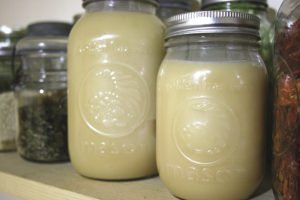I was reorganizing my chest freezer last month to prepare for a delivery of beef from a local farmer. Chest freezers are one of those things that can be a useful household appliance if they’re kept tidy and well organized. Otherwise, they can easily morph into a vacuous black hole that swallows bags of odds and ends into its darkened corners. When storing food in smaller spaces, it’s helpful to keep an updated stock of your inventory.
My freezer isn’t very big, with two or three bags being stacked on one another. I usually separate each type of food in bags and tape a list on the door of the freezer. Once a bag is emptied, I cross that food item off the list. But every now and again, an orphaned bag of fiddleheads or Swiss chard unknowingly disappears, only to be rediscovered with a seasonal clean-out of the freezer. This can be a pleasant surprise: finding a bag of blueberries that you thought you had none of until the next harvest. In my case, I found about 15 pounds of pig fat and skin that a friend gave to me earlier last year. With freezer space at a premium (and questioning myself: why pay money to store something that doesn’t need to be frozen?) now was the time to turn this fat into a useful product.
Animal rendering is a process that converts animal tissue and other inedible parts into value-added materials. More narrowly, it refers to the rendering of whole animal fatty tissue into purified fats, like lard from a pig or tallow and suet from beef.

Traditionally, this important skill has been used to make staple goods like soap and candles, and was commonly used at home in cooking and baking. Today, it is found less in the home and more on a commercial scale. The animal rendering industry converts animal by-products into pet food, feed supplements, fuel, glues, cosmetics—even currency. The Bank of Canada recently confirmed that its polymer banknotes may contain traces of tallow. According to Rothsay, one of Canada’s largest rendering operations with six processing facilities in the country, only about 50 percent of a cow, 60 percent of a pig, and 72 percent of a chicken actually land on grocery store shelves. The rest—in addition to anything that’s expired and returned—typically ends up at an animal rendering plant.
Many supermarkets today receive fresh meat already cut and packaged, leaving less palatable items like kidneys, feet, ears and brains off their shelves. Finding bones for soup, or for your dog, can sometimes be tricky.
Unless you raise the animal yourself, you’ll probably have to source your animal rendering fat from a local butcher, farm or abattoir. The process itself is pretty straightforward. I’ve rendered pork fat in a cast iron pan and unknowingly made pork rinds, the crispy skin that’s leftover.
Using a slow cooker is by far the simplest way I’ve found to make lard using electric heat: add about a quarter cup of water, the chopped fat, and let it simmer for a few hours. Strain the liquid through cheesecloth and pour into a heat-proof container to cool.
If you enjoy eating meat, animal rendering is one more way toward using the whole animal and developing a deeper appreciation for its life.
By Julia Prinselaar

